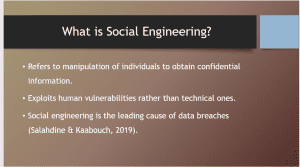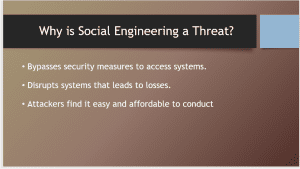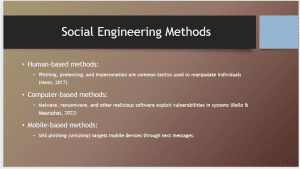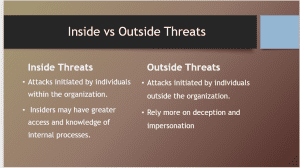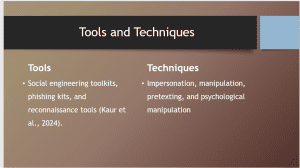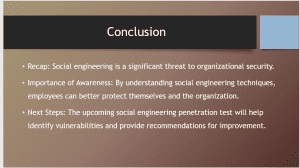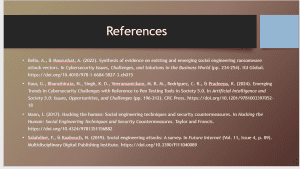Social Engineering Penetration Testing – Process, Methods, and Defense Strategies
Hello and welcome to this discussion on social engineering and its role in penetration testing. This presentation aims to equip you with a clear understanding of the social engineering landscape before we begin the social engineering penetration test. In today’s presentation, we’ll explore how social engineering works, the different methods attackers use, and how we can use a social engineering penetration test to identify vulnerabilities within your organization. By understanding these threats, we can create a more secure environment for your employees, data, and customers.
Social engineering refers to the manipulation of individuals to obtain confidential information. It normally preys on human vulnerabilities. Unlike hacking which focuses on exploiting technical weaknesses, social engineering targets the human element. Attackers use psychological manipulation to gain trust, create a sense of urgency, or exploit our desire to help. This allows them to bypass technical safeguards and gain access to sensitive information or systems. Organizations need to educate employees about social engineering tactics to prevent falling victim to such attacks.
Social engineering is a major threat because it bypasses even the most sophisticated technical security measures. Studies show that human error plays a significant role in data breaches, and social engineering exploits these weaknesses (Salahdine & Kaabouch, 2019).
Technical security is essential, but it’s not enough. Social engineering attacks can bypass firewalls, anti-malware software, and other defenses because they target the human element. This makes them a significant threat, especially considering their relative ease for attackers. The employee ’ access are used to steal company secrets and confidential information or disrupt systems resulting in losses for the company.
Human-based methods are Social engineering techniques that rely on human interaction. Examples are Phishing, pretexting, and impersonation (Mann, 20117). These methods exploit human trust, curiosity, or lack of awareness to deceive individuals and gain access to confidential information.
Computer-based methods are social engineering techniques that exploit vulnerabilities in computer systems. Examples are malware, ransomware, and other malicious software (Bello & Maurushat, 2022). These methods use malicious software or code to compromise systems and obtain sensitive data.
Mobile-based methods are social engineering techniques targeting mobile devices. Examples are SMS phishing (smishing), fake apps, and Bluetooth hacking. These methods exploit vulnerabilities in mobile platforms to deceive users and gain unauthorized access to personal information.
Social engineering threats, which pose a significant risk to organizations, can originate both internally and externally. While internal threats may arise from disgruntled employees or individuals lacking adequate security awareness, external threats tend to cast a wider reach. External perpetrators often employ tactics such as phishing scams to target a broad spectrum of potential victims, exploiting vulnerabilities in the organization’s defenses. Consequently, it is crucial for businesses to adopt comprehensive security measures to mitigate the risks posed by both internal and external social engineering threats.
Social engineers are equipped with a broad range of tools like social engineering toolkits, phishing kits, and reconnaissance tools (Kaur et al., 2024) that they have refined for malicious intentions. Among these methods, searching online for information about your business and its personnel is a common tactic that lets them customize their attacks for maximum impact. This personalization of attacks can take the form of well-known techniques like Impersonation, manipulation, pretexting, and psychological manipulation
Capturing credentials is the ultimate goal of the attack. Attackers use various techniques to trick victims into revealing usernames, passwords, or other sensitive information. Phishing scams are a prevalent method, using deceptive emails and websites to steal login credentials. Vishing, on the other hand, leverages phone calls to pressure or trick individuals into divulging this information. Physical access to unlocked computers or written-down passwords can also be exploited by attackers who gain physical entry.
Social engineering attacks are not targeted at specific individuals; they aim to exploit common human traits. Everyone in your organization, from salespeople to warehouse personnel, can be a target. Attackers prey on trust in authority figures, helpfulness towards others, fear of negative consequences, and even simple curiosity. By understanding these vulnerabilities, we can design a penetration test that effectively identifies weaknesses in your security posture.
The penetration test has two main goals: to identify vulnerabilities and to raise awareness. We will simulate real-world attacks with your prior approval, using a variety of methods to target different human vulnerabilities. The results of the test will help us understand where your organization stands in terms of social engineering preparedness. We will then provide recommendations to strengthen your security policies, procedures, and employee training.
In conclusion, it is imperative to recognize that social engineering poses a substantial threat to the security of organizations in various sectors. The significance of raising awareness about social engineering lies in its ability to empower employees with knowledge on how to safeguard not only themselves but also the overall well-being of the organization they work for. Looking ahead, the forthcoming social engineering penetration test is poised to play a crucial role by uncovering existing vulnerabilities within the system and subsequently offering valuable insights and actionable recommendations to elevate security protocols and minimize risk exposure moving forward.
ORDER A PLAGIARISM-FREE PAPER HERE
We’ll write everything from scratch
Question
Imagine you have been hired to conduct a social engineering penetration test by a flooring sales and installation company with showrooms, warehouses, and offices throughout the state. Recently, several employees, including the company’s president, fell prey to a phishing scam. The company’s leadership realized they needed to better understand social engineering to better protect the company, the employees, and their customers. The first step is to present a general overview of social engineering and how social engineering threats function in preparation for the social engineering penetration test to the leadership team.

Social Engineering Penetration Testing – Process, Methods, and Defense Strategies
Create a 10- to 12-slide media-rich presentation with speaker notes providing your client with details on how the social engineering penetration test will be conducted. Include the following information:
Explain the concept of social engineering and how it can threaten the security of an organization.
Describe human-, computer-, and mobile-based methods of social engineering.
Explain the differences between social engineering threats from inside and outside an organization.
Identify tools and techniques used in a social engineering campaign.
Explain how credentials are captured.
Describe the target audience and what characteristics will be exploited in your social engineering penetration test.
Format your references according to APA guidelines.


